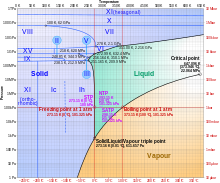Ice Ic
Ice Ic (pronounced "ice one c" or "ice I c") is a

Apart from forming from supercooled water,[5] ice Ic has also been reported to form from amorphous ice[2] as well as from the high-pressure ices II, III and V.[6] It can form in and is occasionally present in the upper atmosphere[7] and is believed to be responsible for the observation of Scheiner's halo, a rare ring that occurs near 28 degrees from the Sun or the Moon.[8]
Ordinary water ice is known as ice Ih (in the Bridgman nomenclature). Different types of ice, from ice II to ice XIX,[9] have been created in the laboratory at different temperatures and pressures.
Some authors have expressed doubts whether ice Ic really has a cubic crystal system, claiming that it is merely stacking-disordered ice I (“ice Isd”),[10][11][12] and it has been dubbed the ″most faceted ice phase in a literal and a more general sense.″[13]
However, in 2020, two research groups individually prepared ice Ic without stacking disorder. Komatsu et al. prepared C2 hydrate at high pressure and decompressed it at 100 K to make hydrogen molecules extracted from the structure, resulting in ice Ic without stacking disorder.[14] Del Rosso et al. prepared ice XVII from C0 hydrate and heated it at 0 GPa to obtain pure ice Ic without stacking disorder.[15] Pure ice Ic prepared in the latter method transforms into ice Ih at 226 K with an enthalpy change of -37.7 J/mol.[16]
See also
- Ice I, for the other crystalline form of ice
References
- S2CID 101738967.
- ^ S2CID 4180631.
- PMID 16482260.
- .
- S2CID 4233237.
- .
- S2CID 4427815.
- PMID 17748273.
- ^ Flatz, Christian; Hohenwarter, Stefan. "Neue kristalline Eisform aus Innsbruck". Universität Innsbruck (in German). Retrieved 2021-02-18.
- .
- ^ Chaplin, Martin (15 September 2019). "Stacking disordered ice; Ice Isd". Water Structure and Science. London South Bank University. Archived from the original on 22 Oct 2020. Retrieved 3 December 2019.
- PMID 25380218.
- PMID 23236184.
- PMID 32015342.)
{{cite journal}}: CS1 maint: multiple names: authors list (link - S2CID 195820566.)
{{cite journal}}: CS1 maint: multiple names: authors list (link - PMID 37227149.)
{{cite journal}}: CS1 maint: multiple names: authors list (link

